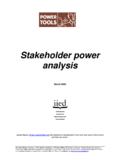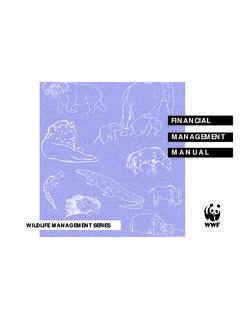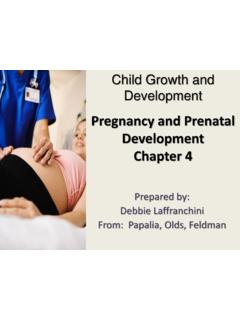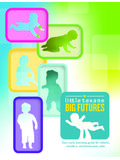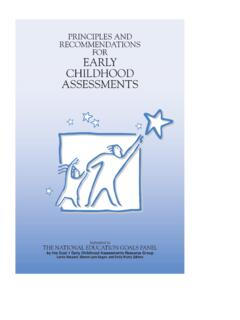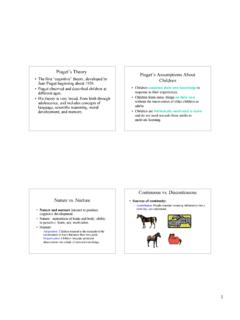Transcription of The four Rs - Power tool
1 We acknowledge the support of The Netherlands Ministry of Foreign Affairs (DGIS) and the German Federal Ministry for Economic Cooperation (BMZ) who have financed the development of these tools, and the UK Department for International Development (DFID) who provided the start-up support. For more information on Power Tools please visit The four Rs March 2005 James Mayers has steered the development of this tool, from work in the forestry and land use sector. 2 Summary The four Rs is a tool which can be used to clarify the roles played by different stakeholders and the nature of relationships between them.
2 Assessment and negotiation amongst stakeholders of these roles and relationships is necessary before developing the capacities needed for improving policies and institutions. The four Rs tool aims to operationalise the concept of roles by unpacking these into Rights, Responsibilities, Revenues (benefits) of stakeholders, and the Relationships between stakeholder groups. This is particularly useful in contexts where roles need re-thinking, negotiating and developing. The four Rs may be seen as a complement to stakeholder Power analysis, and may form a useful tool to apply as part of it, since it can.
3 Explore stakeholders relative powers, by proxy assessment Assess stakeholders mutual relationships Pave the way for role negotiation by establishing stakeholder dialogue and agreement While the four Rs was developed as a framework and tool for working towards better forestry, it has good potential for use in other aspects of natural resource management and the policies and institutions associated with them. What are The four Rs? The Fours Rs is a name given to a tool for looking at stakeholder roles. Roles are patterns of behaviour, routines and responses, like parts in a play.
4 Actors in a play cannot act out any old part and say what they like. They have to speak the lines written. However, even if roles are written we can improvise and interpret our roles, although there are constraints. So roles are not the same as job-descriptions, which are highly specific, handed out and often cast in stone . Roles evolve and become more effective over time as role players discover new opportunities and dimensions in them. To play a role well the role-player needs to interpret the role, to identify with it, develop it and work towards owning it.
5 Thus, roles need to be steadily internalised and strengthened through practical actions. The four Rs framework provides a step towards internalising and strengthening stakeholder roles by first unpacking them into rights , responsibilities and revenues (which could also be described as returns, rewards or benefits), and then assessing the relationships between them. This unpacking enables clarity to develop about the nature and objectives of roles and relationships, and identification of the capacity needs for reconciling different interests.
6 Stakeholder Roles Rights Responsibilities Relationships Revenues Why and when to use Most people would agree, these days, that the sustainable use and management of natural resources requires collaboration between different stakeholders. However, collaboration does not develop merely through people agreeing that it should; there are often considerable differences in Power amongst those using or dealing with natural resources. These aspects of natural resource 3management is often weakly dealt with by government departments, local institutions and development agencies, in part due to a lack of tools to assess stakeholders roles, and lack of capacity to manage role changes.
7 Furthermore, as the range of stakeholder groups concerned with natural resource management broadens, the complexity of the inter-linkages between them increases, as do the pressures on natural resources at local, national and international levels. In such contexts, the potential for conflict is high, and tools are needed to examine and address these relationships. Only then can capacities be developed for reconciling different interests in the hope of transforming battlefield natural resource use into shared assets capable of meeting divergent needs.
8 Moving towards shared decision making requires an unashamedly political approach capable of engaging with the complex links between policies, markets, institutions and capacities. The four Rs framework can be a useful addition to the toolbox for this. Situations where it may be particularly useful include: 1. To analyse multi-stakeholder situations and diagnose problems. The framework has been used to identify, and open discussions on, imbalances between private operators responsibilities and their rights and benefits, and the health of relationships between the State and other stakeholders.
9 2. To assess and compare policies - an analysis of the strengths and weaknesses of policies, carried out in Zambia, revealed a lack of harmonisation of the different forest regulations in terms of both formal and actual rights and responsibilities. 3. In role negotiation processes. To date this framework has not been widely used in negotiation processes, but experience of its use in this way in, for example, the DFID-funded Mount Cameroon Project suggests that it can be usefully adapted and developed for this. 4. As an evaluation tool in the project cycle.
10 The framework can be used as a tool to evaluate natural resource management projects in terms of their performance on the four Rs. For example project objectives and results can be compared in relation to the four Rs; or a SWOT analysis (Strengths, Weaknesses, Opportunities and Threats) of the four Rs can be carried out. 5. In institutional re-structuring and decentralisation the four Rs framework has been used by peasant associations in Senegal to help them to reposition themselves vis a vis government bodies in the context of recent progress towards decentralisation.
